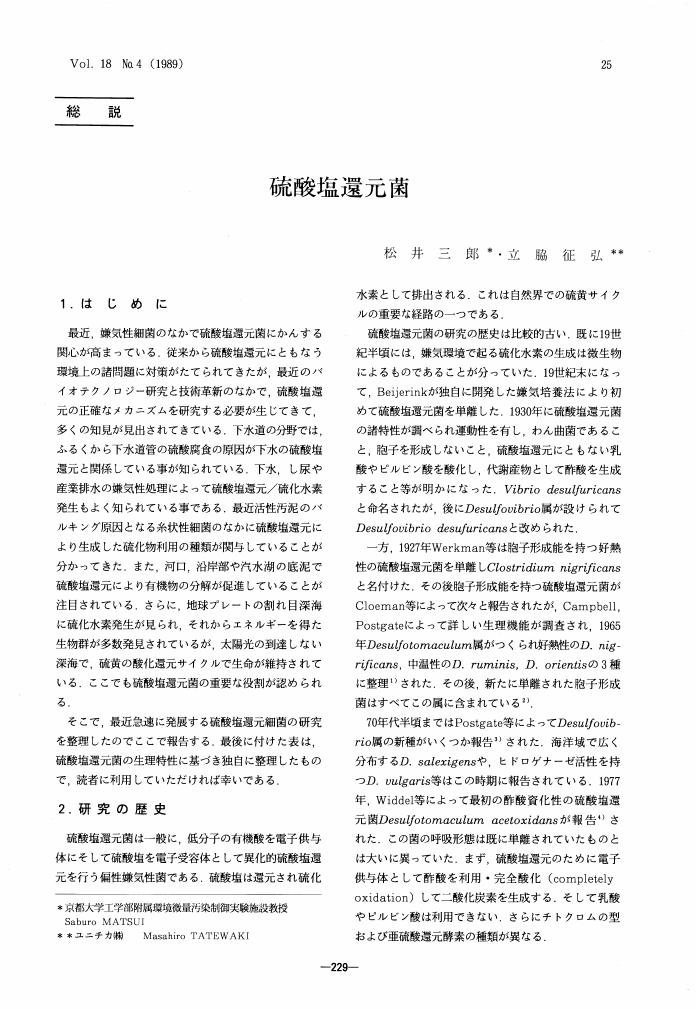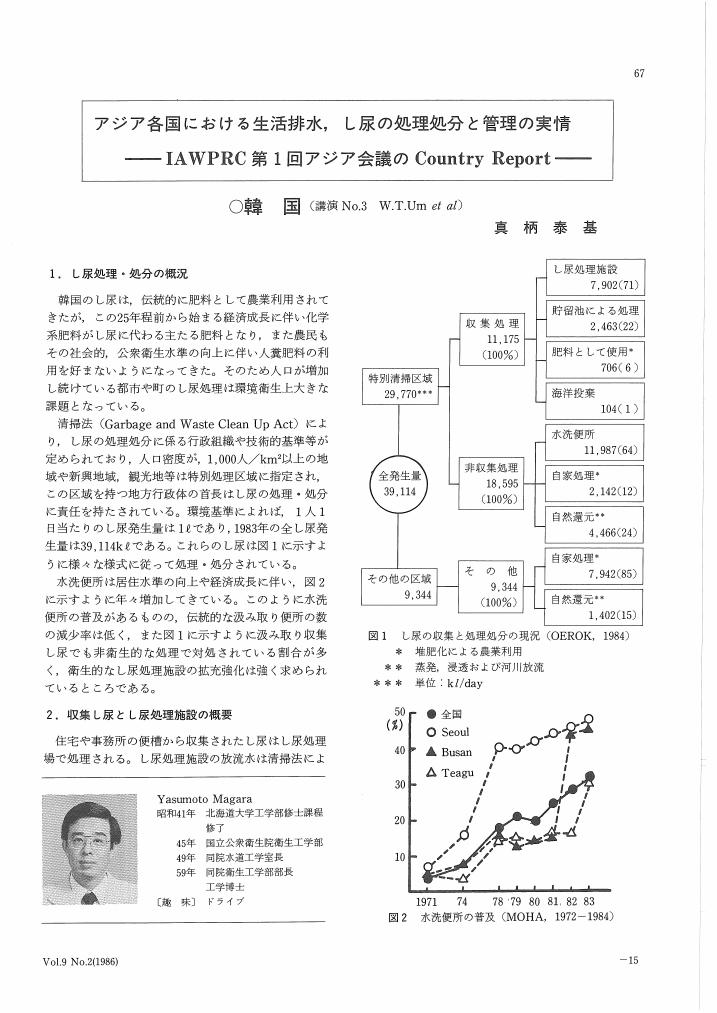4 0 0 0 OA 古代遺跡モヘンジョダロにおける給排水システムの再考
- 著者
- 中村 隆志 楠田 哲也 市川 新 松井 三郎 盛岡 通
- 出版者
- Japan Society of Civil Engineers
- 雑誌
- 土木史研究 (ISSN:09167293)
- 巻号頁・発行日
- vol.15, pp.87-96, 1995-06-09 (Released:2010-06-15)
- 参考文献数
- 29
Mohenjo-Daro is widely known as one of the largest cities of Indus Civilization and with its numerous brick-made structures. In particular, its drainage system is unique among the other remains flourished at the same period of Mohenjo-Daro. As yet, this system has been interpreted as simple sewer based on the results of past archaeological researches, however few researches with the engineering point of view have been made. Therefore, the authors approached to its water supply-drainage system with the civil engineering view and tried to investigate the original purposes of the drainage system. This supply-drainage system includes some pieces of software such as water supply capacity, rainfall intensity, and water use form and also hardware such as sewer, well, and soak-pit. As a conclusion, this drainage system seems to have been made mainly for the removal of waste water from floor-paved rooms near wells.
2 0 0 0 OA 環境ホルモンによる水質汚染の問題
- 著者
- 松井 三郎
- 出版者
- The Resources Processing Society of Japan
- 雑誌
- 資源処理技術 (ISSN:09124764)
- 巻号頁・発行日
- vol.47, no.2, pp.103-109, 2000-06-01 (Released:2009-06-05)
- 参考文献数
- 5
2 0 0 0 古代都市モヘンジョダロの衛生思想とその現代的意義
- 著者
- 市川 新 松井 三郎 楠田 哲也 盛岡 通 アーマド カウザー カーン ジャミール
- 出版者
- 公益社団法人 土木学会
- 雑誌
- 環境システム研究 (ISSN:09150390)
- 巻号頁・発行日
- no.22, pp.432-437, 1994
In the old civilization at Moenjodaro, there were many conduits and open channels, which were told they were used as a sanitary sewer. However, this civilization was very old and hadn't succeeded by the comtemporary races and/or nations, therefore it is very difficult to identify its real purposes. In this research, based on the field survey we would like to focus on understanding the real purpose of their drainage system.
2 0 0 0 OA 硫酸塩還元菌
2 0 0 0 OA 屎尿分離トイレを用いた尿からのMAP回収プラントの開発
- 著者
- 原田 英典 清水 芳久 佐藤 大介 宮越 優 松井 三郎 松田 知成 長坂 俊樹
- 出版者
- 公益社団法人 日本水環境学会
- 雑誌
- 水環境学会誌 (ISSN:09168958)
- 巻号頁・発行日
- vol.29, no.7, pp.383-388, 2006 (Released:2010-01-09)
- 参考文献数
- 14
- 被引用文献数
- 1 1
Human urine can be diverted from faeces by urine diversion toilets. Nutrient recovery from diverted urine has been a growing concern recently, because urine contains many nutrients. Phosphorus in urine can be recovered as a precipitate of MAP (i.e., struvite, MgNH4PO4·6H2O) by adding magnesium salt under alkaline conditions. In this study, we (1) developed a plant for struvite recovery from urine using a urine diversion toilet, (2) investigated the characteristics of the plant's urine collection, urine storage and struvite formation, and (3) analyzed the precipitates formed in the plant. In this report, we present the phosphorus flow in the plant. The plant was mainly composed of a urine diversion toilet, a storage tank and a reactor. Using the toilet, 94.8% of the urine excreted into the toilet was collected and stored in the storage tank. The composition of the stored urine became stable 19 days after the start of urine storage, and 20.8% of the phosphorus in the urine excreted into the toilet was precipitated with other precipitates during urine storage. The reactor recovered 85.0% of the phosphorus in the influent of the reactor, which was 62.0% of the phosphorus in the urine excreted into the toilet. It was considered that most of the recovered phosphorus in the reactor was in the form of struvite.
- 著者
- 真柄 泰基 岡田 光正 松井 三郎 大垣 真一郎
- 出版者
- 公益社団法人 日本水環境学会
- 雑誌
- 水質汚濁研究 (ISSN:03872025)
- 巻号頁・発行日
- vol.9, no.2, pp.67-74, 1986-02-10 (Released:2009-09-10)
1 0 0 0 OA 活性汚泥法における重金属の除去特性
- 著者
- 寺町 和宏 高桑 哲男 松井 三郎
- 出版者
- 公益社団法人 土木学会
- 雑誌
- 衛生工学研究討論会講演論文集 (ISSN:02857316)
- 巻号頁・発行日
- vol.16, pp.72-81, 1980 (Released:2010-03-17)
- 参考文献数
- 2
1 0 0 0 モヘンジョダロの水利施設の目的を推理する
- 著者
- 市川 新 楠田 哲也 松井 三郎 盛岡 通 近藤 隆二郎 カーン ジャミール アーマド カウザー
- 出版者
- 公益社団法人 土木学会
- 雑誌
- 環境システム研究 (ISSN:09150390)
- 巻号頁・発行日
- no.23, pp.332-338, 1995
Moenjo-daro, one of the old civilizations in the world, was equipped with the perfect drainage system, wells and a great bath, which were excavated during 1920-30's, by British archaeologists, Sir John Marshall, Earnest MacKay and others. Those archaeologists supposed that these facilities associated with water had served almost same purpose as those in modern times do. However, there are many things which these hypotheses couldnot explain the real conditions. In this paper we would like to highlight the exact purpose of these water-related facilities, on the basis of hydraulic viewpoints.
1 0 0 0 内因性、外因性ダイオキシン受容体リガンドの代謝と毒性発現経路
ダイオキシン受容体(AhR)は、様々な化学物質を認識することが知られている。外因性のリガンドとしてはダイオキシン、PCB、多環芳香族類などが知られている。また、内因性のリガンドとしては研究代表者の研究で明らかになったインディルビンをはじめ、ICZ、FICZ、DIMなどのインドール化合物が知られている。HPLCとバイオアッセイを組み合わせることにより、環境中には、多種類の外因性リガンドが存在することを明らかにした。染色工場の排水や、下水処理水中はAhRリガンド活性を示した。水環境中のAhRリガンドの単離精製をすすめたところ、いくつかの染料を同定した。この中には、赤ボールペンに使われるローダミンB、黄色染料のHydroxybenzo[b]quinophtaloneなどがあった。また、様々な染料の標準品のAhR活性を調べたところ、アントラキノン系の染料にリガンド活性があることを見出した。さらに、様々な食品中のAhRリガンド活性を調査したところ、コーヒー中に数種類のAhRリガンドがあることをつきとめた。内因性または食品由来のインドール系リガンド、インディルビン、ICZ、FICZ、DIMのAhRリガンド活性を比較した結果、インディルビン、ICZ、FICZのいずれにも極めて強い活性が観察された。また、これらのリガンドは自らが誘導するCYP1A1やCYP1A2によって極めて容易に分解されてしまうことも明らかにした。これらの強いAhRリガンドと、ダイオキシンの毒性の違いは、この代謝のされやすさにあると考えられる。さらに、AhRがリガンド依存的にp21の発現を誘導し、細胞周期に影響を与えるメカニズムの一端を明らかにした。
1 0 0 0 OA 小松天満宮と梯川改修をめぐる環境アセスメント
- 著者
- 松井 三郎 地井 昭夫 内藤 達
- 出版者
- Japan Society of Civil Engineers
- 雑誌
- 環境問題シンポジュウム講演論文集 (ISSN:09134093)
- 巻号頁・発行日
- vol.15, pp.33-39, 1987 (Released:2010-06-04)
- 参考文献数
- 2
The results of environmental assessment on preservation of the Komatsu Tenmanguu Shrine and conservation of the Kakehashi River were reported. The historical and cultural impotance of the shrine which was designated as a national important cultural asset was described. The shrine was also evaluated its importance in the urban planning of Komatsu City. The results of questionare survey to Komatsu citizen on preservation of the shrine and conservation of the river showed that they hoped the both preservation and conservation works were necessary without creating contradiction between them. In conclusion, it was recommended that the city had to make her own urban planning of long range development which includes both the river conservation and the shrine presevation programs.
- 著者
- 大村 浩久 岡田 秀臣 坂井 美鈴 松井 三郎
- 出版者
- 九州大学
- 雑誌
- 九州大學農學部學藝雜誌 (ISSN:03686264)
- 巻号頁・発行日
- vol.30, no.1, pp.21-28, 1975
"Manju (a steam bean-jum bun)" is one of the popular confectioneries pervading all over Japan. It is commonly produced by appropriate steaming a dough of wheat-flour wrapping "an (bean-jum)." On the other hand, "Umegae-mochi" is the special product in Fukuoka. It is produced by baking a dough of glutinous rice flour wrapping "an" in a mold of shape of plum-flower. Regarding respective 5 brands, sensory test and chemical analysis were carried out in order to give some useful guidances for consumers' daily life. Well-known 5 brands of "Manju" in Fukuoka is divided into 2 types of "Dorayaki" and "Kasutera-manju." The former has the following constituents: moisture 27.9~34.0; protein 5.4~5.8; fat 1.0~2.2; starch 58.0~62.9; fiber 0.9~1.0; ash 0.4~0.6; calorie 267~298 Cal. The latter is composed of moisture 21.6~23.5; protein 6.4~6.7; fat 1.3~2.9; starch 66.2~68.7; fiber 0.6~1.2; ash 0.5; calorie 313~318 Cal. On the other hand, chemical analysis of 5 brands of "Umegae-mochi" indicates the following composition: moisture 31.8~39.5; protein 5.1~5.8; fat 0.1; starch 27.0~34.3; sugar 22.0~33.7; fiber 0.6~0.9; ash 0.4; calorie 241~272 Cal. No artificial sweetnesses and preservatives were detected at all. However, artificial pigment, yellow No. 4, was qualitatively detected in 1 brand of "Manju" and that, red No. 2, in 2 brands of "Umegae-mochi." Since standard deviation over F005 was estimated among panels of 7 common house-wives and 3 skillful clerks in the department stores, reliable results of sensory test could obtained for neither "Manju" nor "Umegae-mochi."福岡県内産の代表的銘柄のマンジュウおよび梅ヶ枝餅それぞれ5銘柄を任意に購入L,官能テストおよび理化学テストを行なつた.マンジュウはドラ焼キとカステラマンジュウとの両タイプに分けられたが,その一般成分は前者において,水分31.0%,蛋白質5.6%,脂質1.6%,澱粉60.5%,繊維0.95%,灰分0.5%,熱量285カロリー,後者において,水分22.7%,蛋白質6.5%,脂質1.9%,澱粉67.6%,繊維0.9%,灰分0.5%,熱量315カロリーであつて,いずれも対照(成分表)にくらべ水分含量は低く炭水化物およびカロリー値は高い傾向がある.人工甘味料および保存料は検出されなかつたが,着色料は黄色4号が1銘柄に使用されていた.一方梅ヶ枝餅の成分は水分35.2%,蛋白質5.5%,脂質0.1%,澱粉29.6%,糖分28.5%,繊維0.8%,灰分0.4%,熱量258カロリーであつた.これにも人工甘味料および保存料は検:出されなかつたが,赤色2号の使用が2銘柄に認められた.マンジュウ,梅ヶ枝餅ともに官能テストのすべての項目においてパネル間に有意差があり,正確な嗜好の傾向は求められなかつた.
- 著者
- 大村 浩久 岡田 秀臣 坂井 美鈴 松井 三郎
- 出版者
- 九州大学
- 雑誌
- 九州大學農學部學藝雜誌 (ISSN:03686264)
- 巻号頁・発行日
- vol.30, no.1, pp.35-39, 1975
Chemical analysis of 5 brands of "Kamaboko (fish paste)" and "Chikuwa (rolled fish cake)" indicated the following constituent. "Kamaboko": moisture 75.2~79.1%; protein 11.5~15.0%; fat 0.7~0.8%; starch 2.3~3.1%; sugar 5.0~7.3%; ash 2.6~3.1%; calorie 87~102 Cal. "Chikuwa": moisture 70.1~73.8%; protein 14.3~16.0%; fat 1.1~1.5%; starch 1.2~3.6%; sugar 5.2~6.7%; ash 2.7~3.5%; calorie 101~109 Cal. In "Kamaboko," saccharin sodium and hydrogen peroxide were not detected, while sorbic acid was observed in 3 brands. On the other hand, both saccharin sodium and sorbic acid were detected in all samples of "Chikuwa," whereas hydrogen peroxide not. Intimate relationship of the evaluation of the sensory test to price, chemical constituent or maker was not observed, as those for processed foods examined before. However, it was only suggested that samples of lower protein content were inexpensive and evaluated with lower degree.板カマボコおよびチクワをそれぞれ県内5カ所の生産者から購入し官能テストと成分の分析を行なつた.板カマボコの平均成分は水分77%,蛋白質13.4%,脂質(0.74%,澱粉2.7%,糖分6.3%,灰分2.9%,熱量960カロリ一であつて,炭水化物およびカロリーが僅かに多いほかは対照(成分表)とほとんど差はなかつた.人工甘味料ならびに漂白ないし殺菌剤である過酸化水素はいずれも検出されなかつたが,保存料ソルビン酸は3銘柄に使用されていた.一方,チクワでは水分71.8%,蛋白質15%,脂質1.3%,澱粉2.3%,糖分6.2%,灰分3.2%,熱量106カロリーであつて,対照(成分表)よりは水分含量はかなり低いが,他の成分はいずれも若干高かつた.サッカリンおよびソルビン酸はすべての試料に検出されたが,過酸化水素は認められなかつた.他の加工食品の場合と同様に,価格ないし生産者の知名度と成分あるいは官能テスト間には必ずしも相関関係は認められなかつた.しかし,一応蛋白質含量の低いものは価格も安く評価も低い傾向が認められた.



